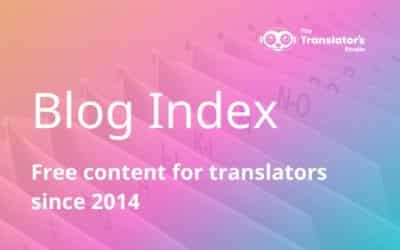Wondering how to get a translation? This is your complete guide to help you get a text translated. I’m going to explain the whole process from start to finish. But, if you want to skip ahead, here’s what to expect:
– How to get a text ready for translation.
– How to find a translator.
– How to order a translation.
– What happens during the translation process?
– Questions, edits and complaints after you get your translation.
How to get a text ready for translation
Finish it
Obvious? You’d be surprised how many customers make edits once the translator has started work. If the writer makes edits to the text, the translator will have to edit the translation. That is one extra cost you can avoid even before you start wondering how to get a text translated.
Figure out timings
The longer the text, the longer it will take to get a translation back. Set a deadline for when you want the translation finished. Then, set a deadline for the text to be written. Make sure you leave enough time for the translator to do their work.
How long does a translation take?
Be safe by planning 2,500 words, or 5 pages, per day.
What is the cheapest text format for translations?
If you supply the text in Word, then that will be the cheapest option. It makes it very easy for the translator to quote a price. It’s also the easiest format to process with translation software. A professional translator with the right software can work with lots of different formats, including PDF, HTML and IDML. But, if the format means the translator has to spend time on presentation, it’ll cost more.
If you’re translating a website, check out this article on website format.
How to get a translation discount on a repetitive text
The easiest way to avoid paying for repeats in your text is to find a translator who works with translation software (CAT tools). They will be able to use them to analyse your text and find repeats. There will probably be a small charge, to cover the time they spend checking these sections, but you’ll get a big discount. This is much more time efficient than for you to spend hours deleting or highlighting sections. Also, you avoid the risk of accidentally leaving things out.
“If you suspect the translator of your text wasn’t a professional, you can ask a professional translator for their opinion.”
Can you translate the text yourself?
If you are a fluent speaker of the language you are going to translate into, you could attempt the translation yourself. It will take a long time and will probably end up looking foreign. Remember that professional translators train for years. Even though they can be near bilingual, they write only in their native languages.
Once you’re finished, you can get a professional translator to edit and proofread your work. This may work out cheaper. But, only do this if you really are proficient at writing in your second language. If the translator can’t understand the text you write, the edit will end up costing the same as a translation. And all your time will be wasted.
Can you use Google Translate and then get a professional translator to correct it?
No. Google Translate still isn’t good enough for that. The translator will be quicker starting from scratch. If you have a very simple text, ask the translator if they can use machine translation to reduce the price.
How to find a translator
While you’re writing your text, you can start looking for a suitable freelance translator.
Where to look for translators
Since you’ve found this website, you already know one place where you can get a translation. We specialise in English and Spanish translations, and manage translation projects in other languages. But if you want to go elsewhere, here are other places where you can find a translator:
Translation agencies. These are intermediaries and so they take a percentage. Good ones have wide networks and solid quality processes. They will probably be more expensive than working directly with the translator.
Find-a-linguist. This is a search feature on the Chartered Institute of Linguists website. Translators have to comply with fairly strict requirements to become members. So, working with a translator on this list (I’m one of them) represents quality assurance.
ProZ.com. Here you can search among thousands of translators and agencies. The biggest difficulty will be separating professional translators from non-pros. Searching for “Certified Pros” (I’m one of them) is one way of obtaining basic quality assurance.
Hello Translator is a web platform where you can search for professional translators. You will also find me there.
How do you know if you have found a professional translator?
Most freelance translators work with customers all over the world. To do this, they must have an online presence. Google their name, e.g. “Gwenydd Jones” (putting it in inverted commas). This will hopefully bring back a useful list of websites where you can spy on them, ahem, look at their credentials.
Things to look for:
• professional memberships, like Chartered Institute of Linguists
• reviews on LinkedIn or ProZ.com
• how quickly they respond to you and if they do it during office hours (translating should be their day job, not a job-on-the-side)
• professional website
• professional quote, terms and conditions, professional invoicing process
• ability to answer your questions knowledgeably
• professional prices.
How do you know if they’re the right translator for your text?
Professional translators tend to specialise in certain areas. When a translator has specialist knowledge, it’s much faster for them to translate a text from that field. It also means they understand the specialist terms, and know how to use them. Since established professionals already have enough work, they won’t be motivated to accept just any text. If they’re uncomfortable with a project, they’ll refuse it. Or perhaps offer to outsource it to a suitable translator. If you’ve found a real professional, then all you have to do is ask them.
How to get a translation quote
Send an email with your details, details of your project and the text. I have written this Translation Quote Guide For Customers, packed with information to help you select a quote. At the end, there is a section called ‘What information to give when you ask for a translation quote’. If you follow those instructions, the process will be much faster.
How to order a translation
Once you’ve selected your translator following the Translation Quote Guide, you can get your text translated.
Important questions to ask before placing your order
• When will you deliver the final text?
• What are the payment terms?
• Is my order subject to VAT?
Normal payment terms for a freelance translator
When you get a text translated, some translators will ask for all or part of the payment upfront. This is because of the risks related to working online. If they haven’t been able to identify who you are, they will logically ask for full payment upfront. Otherwise, expect anything from 7 to 30 days after date of invoice. Cash flow is a problem for freelancers. This means that for big jobs, they may be willing to give a small discount if you offer to pay in advance.
“Even though they can be near bilingual, professional translators write only in their native languages.”
Can you negotiate with a freelance translator
Experienced freelance translators are used to negotiating on price. It’s worth trying to negotiate if you have a large volume or repetitive text. Or if you can offer advantages, like long deadlines, payment in advance, or a regular commitment. Professional freelancers have a lowest price. This price lets them cover their time and costs, while providing a certain level of quality. Once you reach that price, asking them to go below it will mean accepting quality cuts.
What happens during the translation process?
When the translator goes to work, you can kick back and relax, mostly…
What does the translator do?
Professional translators have different processes, depending on their experience, knowledge, tools and personal preferences.
Your role during the translation process
If you have any reference materials provide them at the start. Images are essential if you’re getting a brochure translated, so the translator can see what they’re describing. Style guides and presentation instructions will help translators working on academic texts. Previous translations or glossaries will also be of use if you have them, to ensure terminological consistency.
The translator may need to contact you with questions about your text. Unless the text is extremely complex, a professional translator won’t hound you with their doubts. But, asking a few questions is normal. It’s a sign they’re trying to get the translation right for you.
What happens after translation delivery?
After you get your translation you can expect an invoice to follow. Depending on the translator, they may send it within a few days, or wait until the end of the month.
What if you have questions about the translation?
Professional translators will usually give you a set time to check the translation and raise queries. If you want to query a translation, it’s easiest if you use the ‘Comments’ function in Word. Make the questions or comments as specific as possible, so the translator can give specific answers.
Is it normal to find mistakes in a translation?
Translators are humans and so they make mistakes. However, getting a translation back with a few mistakes is not the same as getting a document full of them. Translators improve with experience and the prices they quote normally reflect that. If you’ve paid for a premium translation, but without a proofreader, then it’s fair to expect very high quality. But, the text may not be error free. Even with a proofreader, the odd small error can slip through the net. If you’re working with a professional translator then they should apologise and correct the error. If you’ve chosen a translator because they’re cheap, you’ll get mistranslations, stiff prose and poor proofreading. This will also be the case if the translator is writing in their second language. When you ask them to correct their mistakes, they may not know how to.
How do you get a translation quality checked?
If you suspect the translator of your text wasn’t a professional, you can ask a professional translator for their opinion. If it’s just a question of having a quick glance and giving you a diagnosis, they’ll probably do that for free. For a more detailed inspection, they’ll likely charge per hour.
What happens if you need to make changes to the original text after the translation has been delivered?
Before doing anything, speak to the translator. If they work with translation software, they may have your text on file. This means you can edit the original text freely. Then, they’ll analyse it for changes and edit the translation accordingly. Otherwise, it’s best to make edits using track changes or a different colour. This will reduce the cost of editing the translation because it saves the translator work.
You now know how to get a text translated. But, do you know how to get a really good translation? Contact us for a quote and we’ll make sure you get value out of your investment.





0 Comments